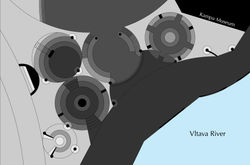The Kampa Island Project is the result of the 2014 Building Bridges Workshop through the Architecture Institute of Prague. In groups of four to five, participants had one and a half weeks of analysis and one and a half weeks of design to propose a re-visioning of their Kampa Island site. Kampa Island is located just south of Charles Bridge on the east side of the Vltava River. Because of its location, it is one of the only places where both tourists and locals routinely mix. It is largely green-space with an assortment of trees, but Kampa Island also houses the Kampa Museum. Locals usually use the island as a space to lay in the grass, walk their dog, or as alternative walking route to avoid the tourist packed streets. Tourists use the space for wandering - an escape from the density of the built city.
The island has six undefined entrances and an inaccessible waterfront. A long wall, the remnants of what used to frame in a long gone renaissance garden, blocks the view of the water across most of the island, making it feel much unlike an island. The wall also blocks the view to the Kampa Island Museum. The museum is hidden to the point where almost no one would find it unintentionally, and even those who are looking for it have difficulty finding
it. While more peaceful than the city, the island doesn’t quite know what it wants to be. Its circulation is confused and disordered with paths splitting just to run parallel to each other and paths leading to dead ends instead of destinations. The traffic on the paths is extremely mixed, hosting pedestrians, bikers, runners, segway riders, and dog walkers alike, with more than just a few collisions pending. Instead of completely overhauling the site, our group decided to attempt to enhance its current function. Our objectives were to:
1) Adjust the circulation to create a clear hierarchy and better flow
2) Create connections to the waterfront and make the banks accessible
3) Turn the Kampa Museum into the focal point of the island
4) Increase site visibility, both to the island and within it
My focus became bringing attention to the Kampa Museum. I started by demolishing the existing renaissance wall and museum gift shop, relocating the giftshop to an unused area of the first floor of the museum. The demolition not only helped make the museum visible but also created lines of sight to the waterfront. The entrance to the museum became a plaza, a hardscaped contrast to the green-scaped island and an open, inviting space usable for community events. In the center of this plaza is a fountain, from which a stream runs, cutting through the museum and into the river, creating a connection
to the waterfront. Alongside the open plaza is a folly which combines articulated ground with raised platforms, creating a space for both stasis and exploration, allowing its occupant the choice of either being in the open or hidden, much like the island itself. It offers places of gathering and of solitude, and the platforms can function as the landscape for the museum's ever changing sculpture garden.
Kampa Island Intervention
 |  |  |
|---|---|---|
 |  |  |
 |  |  |
 |  |  |
 |  |  |
 |  |  |
 |